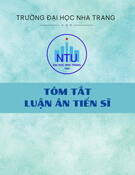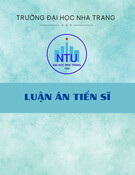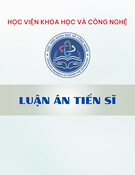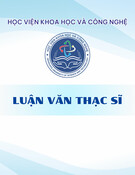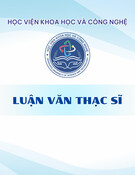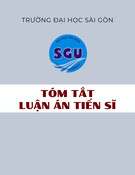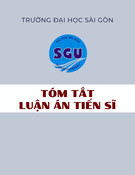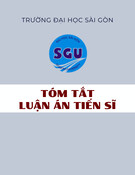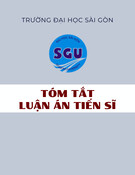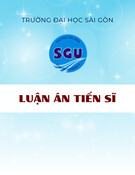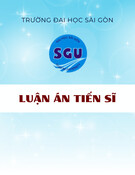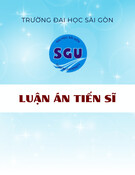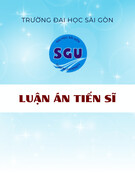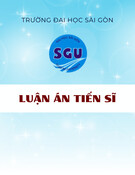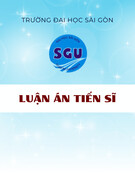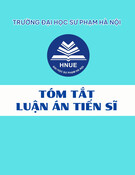
1
MINISTRY OF EDUCATION AND TRAINING
NHA TRANG UNIVERSITY
DINH HUU DONG
REARCHING ON PRODUCTION OF HYDROLYZED
PROTEIN POWDER CONTAINING CHRONDROITIN
SULFATE FROM WHITECHECK SHARK CARTILAGE
(CARCHARHINUS DUSSUMIERI) BY PROTEASES
SUMMARY OF DOCTORAL THESIS
Major: Aquatic Products Technology
Code: 9540105
KHANH HOA – 2021

2
The research has been done at Nha Trang University
The scientific advisors: Assoc.Prof.Dr. Vu Ngoc Boi
Assoc.Prof.Dr. Nguyen Anh Tuan
Reviewer 1: Prof.Dr. Nguyen Anh Dung
Reviewer 2: Assoc.Prof.Dr. Nguyen Thi My Huong
Reviewer 3: Assoc.Prof.Dr. Ngo Dai Nghiep
The dissertation will be defended at the Board of Examiners of
Nha Trang University at 8AM on 26th November, 2021
The dissertation can be found at National Library of Vietnam
Library of Nha Trang University

3
SUMMARY OF NEW CONTRIBUTIONS
OF THE THESIS
Title: Researching on production of hydrolyzed protein powder
containing chondroitin sulfate from whitecheck shark cartilage
(Carcharhinus dussumieri) by proteases
Major: Aquatic Products Technology Code: 9540105
PhD. Student: Dinh Huu Dong Year: 2014
The scientific advisors: 1. Assoc.Prof.Dr. Vu Ngoc Boi
2. Assoc.Prof.Dr. Nguyen Anh Tuan
School: Nha Trang University
Contents:
The dissertation has obtained some new results added to the
field of researching the hydrolysis and making the hydrolyzed protein
powder containing chondroitin sulfate from whitecheck shark cartilage
(C. Dussumieri) oriented for application in dietary supplements:
1) The optimal parameters for the hydrolysis of shark cartilage
were determined: the combination of the Alcalase: Papain with the
ratio of 60/40, the concentration of 0.3%; The ratio of raw materials:
water is 1/1; suitable pH is 6.8; The hydrolysis temperature was 50oC
for 20 hours. The recovery efficiency of chondroitin sulfate was
96.97%. Hydrolyzed protein solution has nutritional energy: 20.42
Kcal/100 ml, chondroitin sulfate content: 40.5 mg/ml, total nitrogen:
7.46 g/l, total mineral: 3.02 g/ l, Zn: 7.63 mg/l, Mg: 205 mg/l, Fe: 4.78
mg/l, the solution contains 18 types of amino acids and meets food
hygiene and safety standards according to current regulations of the
Ministry of Health.
2) Determined the characteristic structure that preserves both
C4 and C6 sulfate radicals of chondroitin sulfate products. The
product is a mixture of 2 isomers GlcA-GalNAc-4SO3- and GlcA-
GalNAc-6SO3-.
3) The optimal parameters for spray drying to create
chondroitin sulfate-containing protein powder from shark cartilage
hydrolyzate were determined: 12% maltodextrin carrier, drying
chamber temperature 80oC, flow rate 12 ml/min and pressure. drying

4
chamber capacity 2.5bar. The recovery efficiency of chondroitin
sulfate was 87.81%. The product has chondroitin sulfate content of
203mg/g, total nitrogen 5.04g/100g, total ash 3.95g/100g, moisture
4.27% and meets microbiological standards for food use as prescribed
of the Ministry of Health.
4) Determining the production process of hydrolyzed protein
powder containing chondroitin sulfate from fresh shark cartilage
hydrolyzate by protease enzyme at experimental scale. Protein
powder products containing chondroitin sulfate meet food hygiene
and safety standards according to current regulations of the Ministry
of Health.
THE SCIENTIFIC ADVISORS 1
PhD. STUDENT
Assoc.Prof. Dr. Vu Ngoc Boi
THE SCIENTIFIC ADVISORS 2
Assoc.Prof. Dr. Nguyen Anh Tuan
Dinh Huu Dong

1
PREAMBLE
1. The urgency of the thesis
The chondroitin sulfate (CS) is the basic component that makes
cartilage and joints and makes up the elastic fibers (tendons, muscles,
ligaments ...) to help in flexible movement and elasticity in joint
activities, creating durability when pressed. The chondroitin sulfate
increases mucus production and lubricity of joint fluid, ensuring
nutritional function and flexible movement of joints. Therefore, the
chondroitin sulfate is used to support the treatment of bone and joint
diseases, and to reduce the degenerative joint process. The chondroitin
sulfate also plays a role in protecting joint cartilage by inhibiting enzymes
that destroy joint cartilage such as collagenase, phospholipase A2, N-
acetylglucosamindase. In addition, the chondroitin sulfate also
contributes to the growth and regeneration of the cells of the eye cornea.
The chondroitin sulfate is obtained mainly from natural sources,
of which, fish cartilage, especially the shark cartilage, usually has a
higher chondroitin sulfate content than other animals. That is why the
cartilage is often used in chondroitin sulfate extracts to produce
functional foods that aid in the treatment of osteoarthritis. Chondroitin
sulfate often binds to protein by o-glycoside links to form a proteoglycan
(PG) (glucoprotein) located in the structure of cartilage tissue, so it is
difficult for humans to absorb. Currently there are some studies using
chemical agents or enzymes to hydrolyze dried or fresh fish cartilage and
precipitate the chondroitin sulfate used in functional food production.
However, only intake of the chondroitin sulfate leads to wastage of
natural substances from the fish cartilage, ineffective use as well as
limited production efficiency and expensive product cost. To deal with
these problems, we have conducted research using enzymes in the fresh
shark cartilage hydrolysis with a desire to create a hydrolysis solution
containing substances from the fish cartilage and the chondroitin sulfate
to be used as food providing essential ingredients to help support
osteoarthritis. Therefore, the thesis conducted: “Researching
on
production of hydrolyzed protein powder containing chondroitin sulfate
from whitecheck shark cartilage (C. dussumieri) by proteases”.

